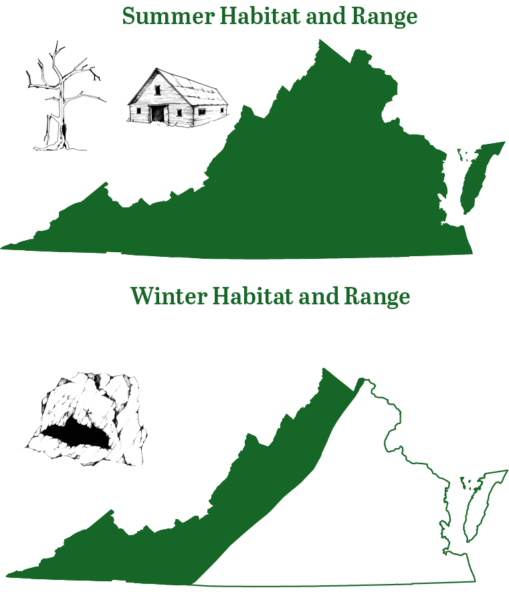Fact File
Scientific Name: Perimyotis subflavus
Classification: Mammal, Order Chiroptera
Conservation Status:
- Species of Greatest Conservation Need-Tier 1a on the Virginia Wildlife Action Plan
Identifying Characteristics
The tri-colored bat is one of the smallest bats found in the state, weighing between 0.1–0.3 ounces and measuring 2.8–3.5 inches in length. The tri-colored bat is quite distinctive with several characteristics that make it easy to identify. Befitting the species name, this bat’s fur is tricolored: dark at the base, whitish in the center, and reddish brown at the tip. The forearm has a pink or reddish coloration that is easy to see when the bat is roosting. During hibernation, this bat often has considerable amounts of condensation on its body.
Habitat
It is more tolerant of warmer hibernacula temperatures than other species and even shows a preference for warmer areas of caves. It is a solitary hibernator and is widely distributed among the Commonwealth’s caves. When not hibernating, these bats lead a relatively solitary lifestyle, but they are sometimes found in small colonies in hollow trees.
Diet
The tri-colored bat is one of the first bats to emerge in the early evening and can be observed feeding at treetop level. It feeds on small flies, beetles, true bugs, and flying ants.
Distribution:
The tri-colored bat is found throughout the state in the warmer months, but hibernates in caves and rock shelters in the mountains during winter.

Reproduction
Females form small maternity colonies in the spring, and twins are frequently born each year. Pups develop quickly: they begin to fly in about three weeks and are left by their mothers about one week later.
Flight
It has a slow, fluttering flight that closely resembles that of a moth.
Conservation
White-nose syndrome is the primary threat to this species. Protection of hibernacula and maternity colonies are conservation priorities.
Last updated: January 19, 2024
ShopDWR
Order your copy of A Guide to the Bats of Virginia, along with more gear, guides, and gifts!
Visit ShopDWRThe Virginia Department of Wildlife Resources Species Profile Database serves as a repository of information for Virginia’s fish and wildlife species. The database is managed and curated by the Wildlife Information and Environmental Services (WIES) program. Species profile data, distribution information, and photography is generated by the Virginia Department of Wildlife Resources, State and Federal agencies, Collection Permittees, and other trusted partners. This product is not suitable for legal, engineering, or surveying use. The Virginia Department of Wildlife Resources does not accept responsibility for any missing data, inaccuracies, or other errors which may exist. In accordance with the terms of service for this product, you agree to this disclaimer.

